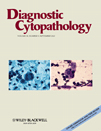A cell-block preparation using Glucomannan extracted from Amorphophallus konjac
Abstract
To evaluate a cell-block preparation using glucomannan, which was extracted from Amorphophallus konjac. Ten specimens were centrifuged at 1,500 rpm for 5 minutes, the supernatant was removed; the remnant after the preparation of smear specimens for routine cytological examination was fixed with 20% formalin. The specimen was recentrifuged at 1,500 rpm for 5 minutes, and the supernatant was removed. The residue was resuspended with 2 ml of eosin solution and 1–5 ml of 80% alcohol, and stirred well. After further centrifugation, the supernatant was removed, and one drop of a glucomannan-formalin water solution was added gently. After immersion in methanol for 2 hours, glucomannan is solidified and becomes gelatinous. The obtained cell block was placed in the cassette for the preparation of tissue specimens, dehydrated by the routine method, infiltrated with paraffin, and a paraffin-embedded block was prepared. Thin sections were prepared from the paraffin-embedded cell block, and hematoxylin–eosin (H&E) stain with immunological stains was performed. H&E stain, periodic acid-Schiff reaction, Alcian blue, and immunohistochemical stain were clearly demonstrated.
We evaluated a new modality of cell-block preparation using a glucomannan-formalin water solution. We found that the method was easy to perform and thought it could be useful as an alternative technique for cell-block preparations. Thus, this novel technique should find wide application in the future. Diagn. Cytopathol. 2010;38:652–656. © 2009 Wiley-Liss, Inc.




